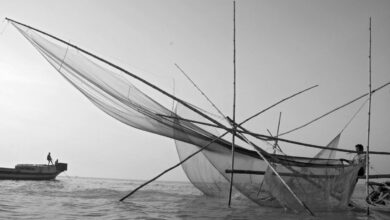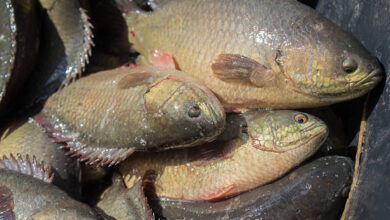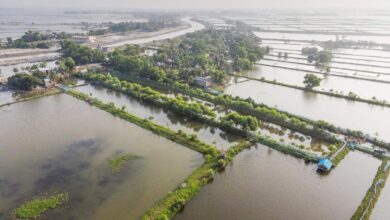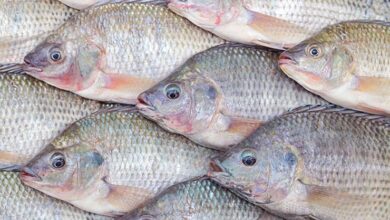Bangladesh has observed a significant surge in fish production over the last 12 years, primarily driven by aquaculture. There are three fish species: Pangasius, Tilapia, and Koi (Anabas testudineus) or climbing perch have contributed to this growth in an outstanding way.
This expansion in fish farming has not only provided a major source of protein for low-income families but has also created numerous job and income opportunities in rural and suburban areas. Approximately 20 million individuals in the country are engaged in fish farming and trade.
The production of these three fish species have witnessed remarkable growth. For instance, the annual production of cultured pangasius increased from 155 thousand tons in 2010-11 to 395 thousand tons in the 2021-22 fiscal year, while tilapia output surged from 98 thousand tons to 329 thousand tons and Koi production rose to a astonishing 350% to reach 57,244 tons during the same period. Overall, cultured fish production in Bangladesh nearly doubled between FY11 and FY22, rising from 1.2 million tons to 2.17 million tons. (Source: Department of Fisheries, DoF)
The increased cultivation of these species can be attributed to factors such as the availability of fish fries, the use of commercial feed, and market demand. The introduction of artificial breeding of pangasius in the 1990s by the Bangladesh Fisheries Research Institute (BFRI) played a pivotal role in their popularity among middle and lower-income groups as well as urban poor across the country, making it a crucial source of animal protein. The high survival rate (close to 100%) of Pangasius fries has further motivated farmers in various regions of the country to engage in fish farming. For example, there are 112 thousand fish farmers in the Mymensingh division, mostly in Trishal, Gouripur, Phulpur, Tarakanda, Bhaluka and Muktagacha upazilas, according to Dilip Kumar Saha, district fisheries officer.
Koi is also a native freshwater fish species and very popular among the fishmongers. Though it had a very low output before the introduction of artificial breeding. Mainly genetically improved Thailand based broodstock has changed its size, weight to double and overall production in the country since 2003. Koi farming is profitable for the farmers as it can be farmed in high density in small ponds even without aerators. This species can sustain a long time without water and in adverse environments. Almost a cent percent survival ratio, low feed cost, several crops per year and high demand in the market made Koi farming popular among the farmers across the country.

Aquaculture industry has emerged as a leading job creator in Bangladesh, as the sector requires significant manpower involvement throughout its value chain. The ease of producing these three fish varieties and the possibility of farming them in household ponds have also contributed to their widespread cultivation, resulting in affordable prices for end-consumers. Getting out of traditional practices and adopting improved farming methods have further boosted production for farmers.
According to International Food Policy Research Institute (IFPRI) report, 56% of Bangladesh’s fish supply originates from ponds, and the practice of fish farming in these ponds has resulted in a nearly six-fold increase in production over the past thirty years. In 1990, the average annual per capita fish consumption was around 7.5 kg, but now it has surged about 30 kg.
The cultivation of Pangasius, Tilapia, and Koi has had a substantial impact on increasing the overall output of fish in Bangladesh, with the total fish production reaching 4.7 million tons in FY22, up about 55% from 3.62 million tons in FY11. Aquaculture now accounts for about 45% of the total output, and led by these three species which is annually 8%. (Source: DoF)
According to Mr. Yahia Mahmud, the director general of the BFRI (Bangladesh Fish Research Institute), “Bangladesh has the potential to enter the market of value-added pangasius products for export. The introduction of “white pangasius” has gained attention from farmers, with the possibility of meeting demand in other countries by exporting“.
White muscle or white pangasius is a Vietnamese breed and has a buttery white flesh which has given them aesthetic benefit over locally framed Pangasius in the country. Local pangasius flesh is more of a yellowish with pink or reddish in colour which is less preferable by the foreign buyers. Though, the white Pangasius farming is yet to gain popularity as there is not much of export activities in the country for this species.
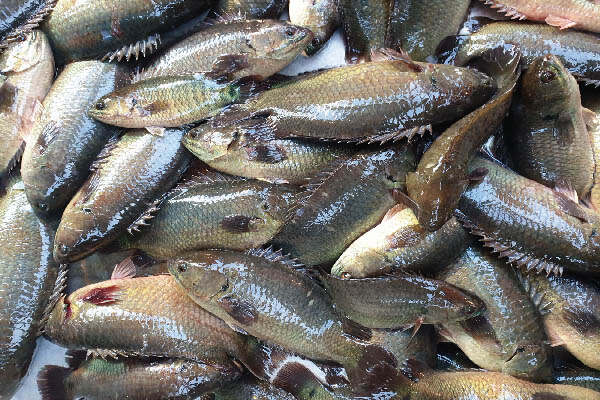
Bangladesh has ranked 3rd for “Inland fish capture production”and 5th for “aquaculture production” in the world in FAO’s State of World Fisheries and Aquaculture 2022, although the country is only 148 thousand square kilometers by area and smaller than half size of Vietnam.
Though when it comes to export, the picture is quite pale. During FY ’22-23, total fisheries sector earning is US $422 million and shrimp accounts for about 71% of the total export value, US $300 million and it was only around 22 thousand tons. Country’s shrimp export is dominated by semi-organic Black Tiger Shrimp (P. monodon) which are cultivated in traditional farming methods.
Bangladesh has 175,000 hectare of land area for shrimp aquaculture (brackish water 155,000 ha, freshwater 10,000 ha) which is more than the land area that India allocated for its shrimp aquaculture (160,000 hectare). Yet, Bangladesh’s shrimp industry is losing its production about 6-8% annually. There were about 140 export-oriented seafood processors in the country, unfortunately only 30 of those processing factories are still manage to stay active and rest have shut-down due to the shortage of raw materials.
Bangladesh govt has recently approved the P. Vannamei for the commercial cultivation to boost up its shrimp export. Though Vannamei cultivation will require a fair amount of time to flourish as its aquaculture value chain (i.e., hatchery, Nursery, technicians) is yet to be developed in the country.
There’s a rising question in the stakeholders, if the industry can’t maximize the benefits from the native species, Black Tiger or monodon shrimp, how will we go along with P. Vannamei.
Pangasius and Tilapia could be a very suitable option to increase aquatic export for the country along with the shrimp. These two species are now being cultivated in both traditional and improved traditional method which leaves ample opportunities to employ advance farming method by leveraging technology and enhance their production to a greater number.
Bangladesh has immense potential as the value-added products from pangasius and tilapia have a good demand in the US, EU and Asian markets. Modern farming methods, more investment at farm level, processing plant’s infrastructure developments and due-diligence from the government can add them into the foreign currency earnings stream and create more job opportunities in the country.


